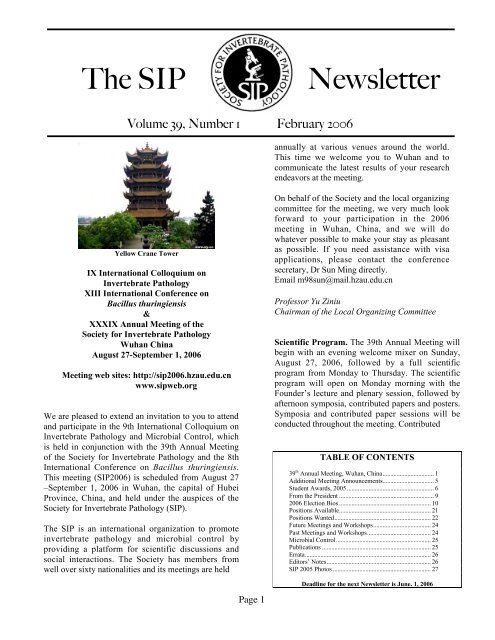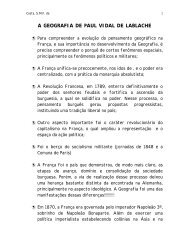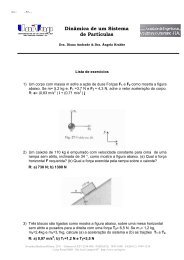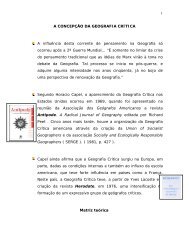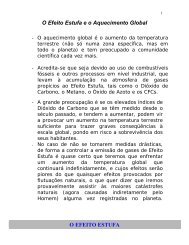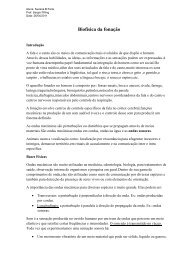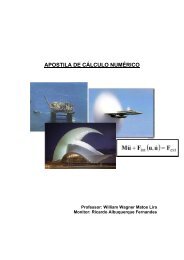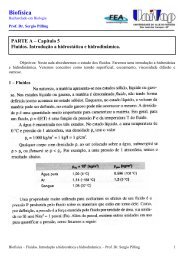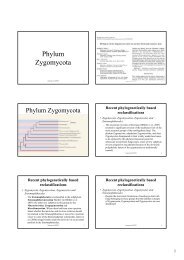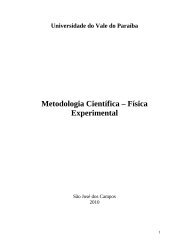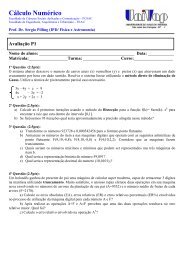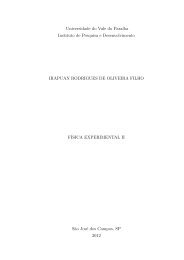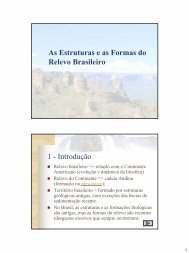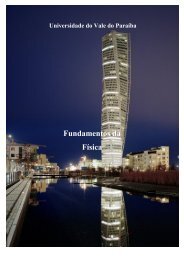The SIP Newsletter - Society for Invertebrate Pathology
The SIP Newsletter - Society for Invertebrate Pathology
The SIP Newsletter - Society for Invertebrate Pathology
You also want an ePaper? Increase the reach of your titles
YUMPU automatically turns print PDFs into web optimized ePapers that Google loves.
February 2006 <strong>Society</strong> <strong>for</strong> <strong>Invertebrate</strong> <strong>Pathology</strong> Vol. 39, No. 1Fungus Division (Chair: Joergen Eilenberg,JEI@KVL.DK)I A Cordyceps symposiumOrganizer: Richard Humber (rah3@cornell.edu)II Ecology of EntomophthoralesOrganizer: Ming-Guang Feng (mgfeng@zju.edu.cn)Microsporidia Division (Chair: Gernot Hoch,hoch@ento.boku.ac.at)I Microsporidia in silk mothOrganizers: Gernot Hoch (hoch@ento.boku.ac.at) andLeellen Solter (lsolter@uiuc.edu)Microbial Control Division (Chair: MichaelBrownbridge (michael.brownbridge@agresearch.co.nz)I Novel approaches <strong>for</strong> dealing with difficult dataOrganizer: Surendra Dara (skdara@ucdavis.edu)II <strong>The</strong> LUBILOSA project in RetrospectiveOrganizer: Roy Batemann (r.bateman@imperial.ac.uk)Nematode Division (Chair: Parwinder Grewal,grewal.4@osu.edu)I Emerging pest targets <strong>for</strong> entomopathogenic nematodesOrganizer: David Shapiro-Ilan(dshapiro@saa.ars.usda.gov) and Richou Han (richouhan@163.net)Virology Division (Chair: James E Maruniak,marun@ufl.edu)I Diseases of aquatic invertebratesOrganizer: Just Vlak (Just.Vlak@wur.nl)II Field per<strong>for</strong>mance of insect virusesOrganizer: Zhihong Hu (huzh@wh.iov.cn)Cross-Divisional Symposia:I Monitoring and managing <strong>for</strong> Bt-resistance: <strong>The</strong>challenges <strong>for</strong> the next decade (MCD & BD)Organizers: Juan Ferre (Juan.Ferre@uv.es) & CarlosBlanco (Cblanco@mas-stoneville.ars.usda.gov)II News in invertebrate immunity: from humoral tocellular response (BD & FD)Organizers: Christina Nielsen-LeRoux(Christina.nielsen@jouy.inra.fr) and Rosalind James(rjames@biology.usu.edu)III Nematodes and Bacteria: from Pathogenicity toMutualism: (BD & ND)Organizers: Raffi Aroian(raroian@biomail.ucsd.edu) and Parwinder Grewal(grewal.4@osu.edu)Workshops:I Microbes commercialized in China/Asia(Microbial Control Division)Organizer: Vince D'Amico(Vincent.D'Amico@usda.gov)II Beneficial and noxious Microsporidia of Asia(Microsporidia Division)Organizer: Regina Kleespies (r.kleespies@bba.de)Deadline <strong>for</strong> abstracts: April 29, 2006<strong>The</strong> Program committee solicits your contributionof abstracts <strong>for</strong> presentations at the meeting.Contributed oral presentations will be limited to 12minutes with an additional 3 minutes <strong>for</strong> answeringquestions. Because of concurrent sessions,moderators will be instructed to keep to thescheduled times. Digital projection and PCcomputer equipments are available. Morein<strong>for</strong>mation about this will be provided shortly(details will be posted on the meeting websitehttp://sip2006.hzau.edu.cn). Posters should be 0.9m (3 ft) wide and 1.2 m (4 ft) tall. Tacks <strong>for</strong>mounting posters will be provided.Participants in the Student Competition will belimited to one presentation, either a poster or acontributed paper, but not both.April 29 is the deadline <strong>for</strong> receipt of abstracts <strong>for</strong>the symposia, contributed papers, poster andplenary presentations. Abstracts received after thedeadline will not be printed and late submissionswill be scheduled as posters if space permits. <strong>The</strong>Program Committee reserves the right to requestthat some contributed papers be presented asposters although this will only be done if absolutelynecessary. <strong>The</strong> printed Program and Abstract bookwill be available only to those registered <strong>for</strong> thePage 3
February 2006 <strong>Society</strong> <strong>for</strong> <strong>Invertebrate</strong> <strong>Pathology</strong> Vol. 39, No. 1Date AM PM EveningAugust 27 Registration Registration & <strong>SIP</strong> Council Meeting MixerOpening Ceremonies,WorkshopsAugust 28 Founder's Lecture, Plenary Symposia and Contributed Papers/Posters & DivisionSessionMeetingsAugust 29Symposia and ContributedPapersExcursion: Yellow Crane Tower & HubeiMuseumOr: Yellow Crane Tower & GuiyuanZenist Temple5K RaceAugust 30Symposia, Contributed Papers & PostersWorkshops& DivisionMeetingsAugust 31 Symposia and Contributed Papers BanquetSeptember 1Post Conference Tours to the ThreeGorges or Xi'an CityBBQmeeting, but this in<strong>for</strong>mation will be made available inelectronic <strong>for</strong>m on the <strong>SIP</strong> website.Excursion Possibilities:Yellow Crane Tower: located at Snake Hill in Wuchangand the South of Yangtze River, is one of the "ThreeFamous Towers" of China.Guiyuan Temple: initially built in the Qing Dynasty(1644-1911) by two monks, is one of the four largesttemples <strong>for</strong> Buddhist meditation in Hubei as well as animportant Buddhist temple in China.Hubei Provincial Museum is the most important researchand collection institution in the province. More than140,000 collections, mainly from a big tomb excavated in1978, are well preserved and maintained here, including645 excellent cultural relics and 16 national treasures.Post-Meeting Tours:<strong>The</strong> Yangtze River is thelargest river in China. Itstretches <strong>for</strong> about 200km from Fengjie City toYichang City and cutsthrough three majesticcanyons named theQutang Gorge, the WuGorge, and the XilingGorge, known as the“Three Gorges”. Visit also the century-spanning Three -Gorges Dam Project on the Yangtze River, which is nowattracting worldwide attention.Xi'an, named Chang'an in ancient times, has witnessedthe rise and fall of numerous Chinese dynasties, andmountains and archaeological sites surrounding the cityPage 4serve as a reminder that once upon a time Xi'anstood at the verycenter of the Chineseworld. <strong>The</strong> TerracottaArmy, potterywarriors and horsesare located 1.5kilometers east of theMausoleum ofEmperor Qin ShiHuang. <strong>The</strong> site wasdiscovered in 1974 and more excavations weremade in the subsequent years.Deadline <strong>for</strong> RegistrationEarly registration: March 1 to April 30Late registration: May 1 to August 18Walk-in registration rates: After August 18On-line registration is strongly encouraged andwill begin March 1, 2006 at:http://sip2006.hzau.edu.cn. However, <strong>for</strong> thosewho prefer to register by mail or fax, registrationmaterials are provided at the website. If you needany further assistance, please contact theconference secretary, Dr Sun Ming(m98sun@mail.hzau.edu.cn).<strong>The</strong> registration fee includes access to the scientificand social program, Program and Abstract book,mixer, barbeque and banquet dinner.Cancellation policy: Refunds <strong>for</strong> cancellations willonly be provided be<strong>for</strong>e August 1, 2006 with a 25%cancellation fee. After August 1, refunds cannot beguaranteed.
February 2006 <strong>Society</strong> <strong>for</strong> <strong>Invertebrate</strong> <strong>Pathology</strong> Vol. 39, No. 1<strong>SIP</strong> <strong>Newsletter</strong> and <strong>SIP</strong> website <strong>for</strong> specificin<strong>for</strong>mation regarding availability of student travelawards <strong>for</strong> 2006.Guiyuan Zenist TempleADDITIONAL MEETING ANNOUNCEMENTSRichard Humber is organizing a symposium, "CurrentPerspectives on Cordyceps", <strong>for</strong> the Division on Fungi toput the current understanding of the dramaticallyexpanding knowledge of the biology and importance offungi in the genus Cordyceps into contemporary focus.Further news on this symposium will be provided as itdevelops; Humber apologizes that health problems (nowresolved!) have delayed his work on this symposium.<strong>SIP</strong> Travel Award ApplicationGeneral Instructions(Please Note!! <strong>The</strong>se instructions apply to both theMartignoni Student Award and the DivisionsponsoredTravel Awards)To apply, you must be a student enrolled in a universitydegree program. You need not be a member of the <strong>SIP</strong> orof any Division sponsoring a travel award. Awardapplicants must submit an abstract of their work to bepresented at the <strong>Society</strong>’s Annual Meeting.Applications <strong>for</strong> all travel awards, both poster and oralpresentations, should be sent to the Chair of the Awardsand Student Contest Committee, Stephen Wraight, email:spw4@cornell.edu. <strong>The</strong> subject matter of thepresentation should pertain to topics in invertebratepathology and/or microbial biocontrol. All individualssubmitting oral presentations will automatically beconsidered <strong>for</strong> the Martignoni Award (posterpresentations are not eligible <strong>for</strong> Martignoni Awardconsideration). Following selection of the MartignoniAward winner, all applications will be <strong>for</strong>warded to theappropriate division(s) <strong>for</strong> travel award competitions.Students and their supervisors are advised to refer to thePage 5<strong>The</strong>re is no limit on the number of awards you mayapply <strong>for</strong> in a single year. However, while youmay be considered <strong>for</strong> multiple awards (<strong>for</strong>example, one or more Division-sponsored awardsand the Martignoni Award), you will be eligible toreceive only one travel award per year. You areeligible to receive the Martignoni Award only onceduring your student career. Consult Division chairs<strong>for</strong> current guidelines on Division Travel Awards.Required In<strong>for</strong>mation1. Curriculum vitae. This should include yourname, address, institution, earned degrees, currentdegree program, honors and awards, researchexperience, and a list of publications and previouspresentations.2. A short biographical sketch and description ofscientific interests and goals.3. A letter from your supervisor providing a 1)recommendation, 2) verification of your studentstatus, and 3) confirmation that the researchpresented was conducted by you (if you are notlisted as the first author of the abstract you submit,your supervisor must explain your specific role inthe research and how you have met thisrequirement).4. Presentation abstract. <strong>The</strong> application mustinclude a one-page summary of the presentationincluding title, authors, and affiliations. <strong>The</strong>presentation category (oral or poster) should beclearly indicated. If your presentation relates tomore than one pathogen group or involvesfundamental studies such as research oninvertebrate immune defense systems, pleaseindicate the division or divisions you feel would bemost qualified to judge your work. Your researchcontribution represents one of the most importantselection criteria. <strong>The</strong>re<strong>for</strong>e, the abstract should becrafted with care, succinctly describing the researchrationale, any unusual or novel methods, and theprincipal results. An explanation of the significanceof the research findings should be offered inconclusion, based on sound interpretation of theresults.5. Brief (one page) description of experimental andanalytical methods employed in conducting theresearch reported in the presentation abstract.
Framkvæmdastjórn TMSigurður ViðarssonForstjóriSigurður hóf störf hjá TM í október 2007. Frá 1997starfaði hann hjá Kaupþingi líftryggingum, m.a. sem<strong>for</strong>stöðumaður fjármálasviðs og staðgengill <strong>for</strong>stjóra.Áður starfaði Sigurður sem greinandi fyrirtækja áhlutabréfamarkaði hjá Glitni banka hf. Sigurður er meðB.Sc. gráðu í viðskiptafræði frá Háskóla Íslands.Hjálmar SigurþórssonFramkvæmdastjóri fyrirtækjaþjónustuHjálmar hóf störf hjá TM í september 1988 fyrst semstarfsmaður í tjónaþjónustu en varð framkvæmdastjórihennar árið 2005. Árið 2008 tók Hjálmar við starfiframkvæmdastjóra fyrirtækjaþjónustu TM.Hjálmar er með MBA gráðu frá Háskólanum í Reykjavík.Ragnheiður AgnarsdóttirFramkvæmdastjóri Einstaklingsþjónustu ogSamskiptasviðsRagnheiður hóf störf hjá TM í apríl 2006 sem <strong>for</strong>stöðumaðureinstaklingsþjónustu. Ragnheiður hefur veriðframkvæmdastjóri frá árinu 2006, fyrst vátrygginga‐ ogfjármálaþjónustu en frá árinu 2008 framkvæmdastjórieinstaklingsþjónustu og samskipta.Ragnheiður er með BA próf í sálfræði og MA gráðu ímannauðsstjórnun frá Háskóla íslands.Óskar B. HaukssonFramkvæmdastjóri Fjármála‐ og rekstrarsviðsÓskar hóf störf hjá TM í ágúst 2006 og hefur veriðframkvæmdastjóri fjármála‐ og rekstrarsviðs frá árinu 2008.Hann starfaði áður sem framkvæmdastjóri upplýsingatækniog þróunarsviðs Vodafone og sem <strong>for</strong>stöðumaðurupplýsingavinnslu hjá Eimskip. Óskar er með gráðu íverkfræði og B.Sc. í tölvunarfræði frá Háskóla Íslands og MBAgráðu frá Ox<strong>for</strong>d Said Business School.THEBUSINESSOFTMKjartan VilhjálmssonFramkvæmdastjóri tjónaþjónustuKjartan hóf störf hjá TM í janúar 2005 sem lögfræðingur ítjónaþjónustu en hann útskrifaðist sem Cand. jur. frálagadeild Háskóla Íslands sama ár. Kjartan var skipaðurframkvæmdastjóri tjónaþjónustu í maí 2008 en áðurvar hann deildarstjóri líkams‐, ferða‐, ökutækja‐ ogábyrgðartjóna. Kjartan er með Cand. Jur. gráðu frá HáskólaÍslands og er héraðsdómslögmaður.Garðar Þ. GuðgeirssonFramkvæmdastjóri Fjárfestinga‐ og viðskiptaþróunarGarðar hóf störf hjá TM í júní 2008. Hann starfaði áðursem ráðgjafi hjá McKinsey & Company í Kaupmannahöfnog framkvæmdastjóri og meðeigandi ÍslenskuVerkfræðistofunnar ehf. Garðar er með B.Sc. gráðu írafmagnsverkfræði frá Háskóla Íslands, M.Sc. gráðu íHugbúnaðarverkfræði frá University of York og MBA fráIMD.9
February 2006 <strong>Society</strong> <strong>for</strong> <strong>Invertebrate</strong> <strong>Pathology</strong> Vol. 39, No. 1January. This is the year of theInternational Colloquium of<strong>Invertebrate</strong> <strong>Pathology</strong> andMicrobial Control, theOlympics of the <strong>Society</strong>.Every fourth year theinternational colloquium isheld to highlight developmentsof our science <strong>for</strong> a wideraudience. I visited Wuhan inOctober 2005 and theorganizers are excited to hostthe <strong>Society</strong> at the end ofAugust 2006. It is the second time the <strong>Society</strong> meets inAsia and it is a good opportunity <strong>for</strong> the members andfuture members to meet with our colleagues in that partof the world. It is also a golden opportunity <strong>for</strong> the<strong>Society</strong> to reach out to many our young Chinesecolleagues.Although somewhat late in the day, I would like to thankthe organizers of the <strong>SIP</strong> meeting in Anchorage in 2005<strong>for</strong> their ef<strong>for</strong>ts in putting together such a wonderfulmeeting in a really stunning environment. Kelli Hooverand Diana Cox-Foster did a superb job as localarrangement committee and Bryony Bonning masteredthe programming as if it was her daily job. <strong>The</strong> wholearrangement really was a ‘once-in-a-lifetime’ experience.<strong>The</strong> research progress was notable and it was nice to seeso many young and enthusiastic students, despite the hightravel costs. It was a great pleasure to hand out theawards on behalf of the <strong>Society</strong> to so many outstandingstudents <strong>for</strong> their excellent oral and poster presentations.In January, the Council had their annual midtermtelephone conference meeting to solve immediateproblems, to identify items <strong>for</strong> the ‘still to do list’ andaddress new issues. Contact with the local organizingcommittee in Wuhan was part of the agenda and we wereupdated on the progress. <strong>The</strong> program is taking shape,organizers of divisional symposia are busy incont(r)acting speakers and the deadline <strong>for</strong> submission ofabstracts is approaching. I had the privilege to be inWuhan at the end of October 2005 and to sample theexcellent conference venue. Among the other items werea review of the awards system, publication and update ofthe Martignoni/Steinhaus glossary (supervised by DavidOnstad) and the review of the various meeting venuesbeyond 2006. By mentioning Steinhaus, it was sad tolearn that Mrs. Mabry Steinhaus, wife of the founder andsecond president of the <strong>SIP</strong>, and affectionate to the<strong>Society</strong>’s affairs, passed away in the autumn of 2005.Communication is a very important aspect of the<strong>Society</strong>. Although our <strong>Newsletter</strong> and our Websiteare convenient conduits <strong>for</strong> exchange ofin<strong>for</strong>mation, we need the help of all our committeesand members to provide both the website and the<strong>Newsletter</strong> with in<strong>for</strong>mation. I also wouldencourage individuals just to chip in some newsfrom their research or institute. Our website isusually the first mode of contact with the <strong>Society</strong>and its activities, so important enough to keep it ingood shape. <strong>The</strong> membership is a major concernthese days <strong>for</strong> any <strong>Society</strong>, but it is nice to see thatthe number of our <strong>Society</strong> has stabilized and isready to take off again. Ray Akhurst and hismembership committee did an excellent job to tracelapsed members and invite them to rejoin. Thisseems a successful strategy as many did respond.<strong>The</strong> majority of our membership increase shouldcome from personal action of our members to askothers to join. You can always contact Ray or PegRotstein, our Executive Secretary, and ask them toapproach potential members.Societies cannot function and flourish if membersdo not volunteer <strong>for</strong> offices. <strong>The</strong>re<strong>for</strong>e, I am verygrateful that we have again a strong slate ofcandidates <strong>for</strong> the next election of the Council.Wendy Gelernter is up <strong>for</strong> President and ready totake over the helm in August. She and her teamdeserve all the support from the membership.I hope to see many of you all in Wuhan and I amlooking <strong>for</strong>ward to enjoy the further advances ininvertebrate pathology and microbial control.Just Vlak, PresidentELECTIONS 2006-2008<strong>The</strong> following candidates <strong>for</strong> election to <strong>SIP</strong> officesin 2006 were selected by the NominationsCommittee and approved by Council. Onenomination <strong>for</strong> honorary membership was receivedand will also be on the ballot. Ballots <strong>for</strong> thiselection will be mailed to members late March to bereturned by mail by May 01, 2006 as indicated onthe ballot.Page 10
February 2006 <strong>Society</strong> <strong>for</strong> <strong>Invertebrate</strong> <strong>Pathology</strong> Vol. 39, No. 1PresidentInnovators Award, Cali<strong>for</strong>nia Environmental ProtectionAgency; 1993–1994: Board of Reviewing Editors,Journal of Economic Entomology; 1991–1995: Member,Bt Resistance Management Working GroupMemberships: <strong>Society</strong> <strong>for</strong> <strong>Invertebrate</strong> <strong>Pathology</strong>,Entomological <strong>Society</strong> of America, National Alliance ofIndependent Crop Consultants, National Association ofScience Writers, Association of Applied IPM Ecologists,Crop Science <strong>Society</strong> of America.Interests: Microbial control of scarabs, developmentand commercialization of microbial pesticides,biopesticides in the developing world, Bt resistancemanagementDr. Wendy GelernterEducation: 1976: B.S. in Agriculture, Cornell University;1984: Ph.D. in Insect <strong>Pathology</strong>, University of Cali<strong>for</strong>nia,Riverside. <strong>The</strong>sis: “Isolation and identification, geneticvariation and control potential of a nuclear polyhedrosis virusfrom the beet armyworm, Spodoptera exigua.”Experience: 1995–present: Owner and Research Director,PACE Consulting. PACE is an independent agricultural andenvironmental consulting company that provides appliedresearch, pest management, agronomic, education andin<strong>for</strong>mation services to the agricultural, turfgrass andhorticultural industries. 1990–1995: Director of BiopesticideCommercial Development, Mycogen Corp.; 1985–1990:Product Manager <strong>for</strong> Bioinsecticides, Mycogen Corp.;1984–1985: Research Scientist, Mycogen Corp.Professional Activities: 2004 – 2006, Vice-President, <strong>SIP</strong>;2001–2003, Chair <strong>SIP</strong> Microbial Control Division; 2000–2006:Chair, <strong>SIP</strong> Fundraising and Endowment Committee; 1999:Member, <strong>SIP</strong> Audit Committee; 1998–2002: Chair, <strong>SIP</strong>Nominating Committee; 1994-1996: <strong>SIP</strong> Secretary;1989–1993: Chair, <strong>SIP</strong> Membership Committee; 2000–2006:Editorial Board, Biocontrol Science and Technology;1999–2000: Chair, Agricultural Biotechnology Task Force,National Alliance <strong>for</strong> Independent Crop Consultants;1998–present: founding member, International BiopesticideConsortium <strong>for</strong> Development; 1996–2000: Association ofApplied IPM Ecologists, Executive Board Member; 1996: Coorganizer,USDA national <strong>for</strong>um on insect resistance toBacillus thuringiensis; 1994–1995: Chair, Insect <strong>Pathology</strong>subsection, Entomological <strong>Society</strong> of America; 1994: IPM<strong>SIP</strong> is unique among scientific societies. Yes, it is truethat we offer many of the benefits that scientists havecome to expect from their professional organizations,including high quality annual meetings, a useful andin<strong>for</strong>mative website, an excellent newsletter, access tospecial publications, and reduced rates on key journals.But <strong>SIP</strong> is unique in offering even more – a supportiveand cooperative community that values the broadspectrum of the disciplines it encompasses as much as itdoes the diversity of its membership. Our annualmeetings serve the dual purpose of advancing scientificknowledge in invertebrate pathology, while at the sametime promoting international collaboration, andrein<strong>for</strong>cing friendships.I felt <strong>for</strong> some time that there are too few peoplebenefiting from what <strong>SIP</strong> has to offer. Our membershiprolls have been stagnant over the past several years. Andwhile our meetings are extremely well attended, the highcost of travel makes it difficult <strong>for</strong> many scientists andtheir students to attend on a regular basis. <strong>SIP</strong> needs togrow a bit, and I believe that this growth can beaccomplished without sacrificing the warm and personalnature that so uniquely characterizes our <strong>Society</strong>.Possible approaches towards this goal include expandedef<strong>for</strong>ts to publicize our annual meetings and toimplement membership drives, especially in thoseregions where future annual meetings are planned.Further student involvement in <strong>SIP</strong> needs to beencouraged via awards, travel grants, and considerationof a greater role <strong>for</strong> students in <strong>Society</strong> affairs.Additional travel grants <strong>for</strong> scientists who have financialdifficulty in attending the meetings should also beexplored. Concerted ef<strong>for</strong>ts to broaden our fund-raisingappeals and to focus member’s volunteer ef<strong>for</strong>ts on theseactivities should make it possible to bring the benefits of<strong>SIP</strong> to a larger audience.Page 11
February 2006 <strong>Society</strong> <strong>for</strong> <strong>Invertebrate</strong> <strong>Pathology</strong> Vol. 39, No. 1Nominees <strong>for</strong> Vice PresidentSubcommittee of the Organizing Committee,International Organization <strong>for</strong> Biological ControlInternational Conference, “Technology Transfer inBiological Control: From Research to Practice”,Montpellier, France; 1997/98: President,Entomological <strong>Society</strong> of Alberta; 1993 - 95:President, Canadian Forum <strong>for</strong> Biological Control;1991-93: Secretary, Entomological <strong>Society</strong> ofAlberta; 1991: Chairman, Working Group on LRSRegional Biocontrol Centre Proposal; 1991-92:Member, LRS Biocontrol Centre Committee; 1991- 95: Chairman, Professional Institute of the PublicService of Canada, Research Scientist LethbridgeSubgroup; 1990 - 95: Member, PIPSC-Management Consultative Committee.Memberships <strong>Society</strong> <strong>for</strong> <strong>Invertebrate</strong> <strong>Pathology</strong>,Entomological Societies of Canada and Alberta,International Organization <strong>for</strong> Biological Control,Canadian Forum <strong>for</strong> Biological Control, <strong>The</strong>Canadian Biocontrol NetworkDr. Mark GoettelEducation: 1975: B.Sc. in Biology, ConcordiaUniversity1977 M.Sc. in Insect Ecophysiology, University ofOttawa1987: Ph.D. in Insect <strong>Pathology</strong>, University of Alberta.Experience: 1988 - Present: Research Scientist, Insect<strong>Pathology</strong>, Agriculture and Agri-food Canada,Lethbridge Research Centre; 1987 - 1988: NSERCPostdoctoral Fellow, Insect <strong>Pathology</strong> Resource Centre,Boyce Thompson Institute, Cornell University; 1978 -81: Research Entomologist, Dept. of Health, Suva, Fiji.Service to <strong>SIP</strong> Member of the <strong>Society</strong> since 1983;Member of Divisions on Microbial Control andFungi; 2001 - present: Chair, <strong>SIP</strong> MeetingsCommittee; 1997: Chair, <strong>SIP</strong> Local MeetingArrangements Committee, Banff 1997; 1991 - 93:Assistant Editor, <strong>SIP</strong> <strong>Newsletter</strong>; 1993 - 2001Editor, <strong>SIP</strong> <strong>Newsletter</strong>; 1994 - 98: <strong>SIP</strong> Trustee;1993: Chair, Safety Publications Subcommittee;1989-91: Chairman, <strong>SIP</strong>, Division on MicrobialControl, past-chair, 91-93; 1985/86: Member, <strong>SIP</strong>New Initiatives Committee.Interests Microbial control of insect pests, developmentand commercialization of microbial control agents, safetyand registration of microbials and more specifically,regulatory requirements and their impact of microbialcontrol.Professional Activities: 1996 - present: AdjunctProfessor, Simon Fraser University; 2001 - present:Editor-in-Chief, Biocontrol Science and Technology;1996- present: Member, Editorial Board, BiologicalControl; 2001 - 2002: Member, Board of Directors, <strong>The</strong>Biocontrol Network;1999: Member, Organizing Committee, InternationalSymposium, Biological Control Agents in Crop &Animal Protection, University of Wales, Swansea; 1999 -2004: Chair, Bylaws, Rules and Regulations Committee,Entomological <strong>Society</strong> of Canada; 1998: Member,Organizing Committee, British Mycological <strong>Society</strong>Symposium, <strong>The</strong> Future of Fungi in the Control of Pests,Weeds and Diseases, Southampton, United Kingdom;1997 - 2000: Director-at-Large, Entomological <strong>Society</strong> ofCanada; 1996: Member, Scientific ProgramPage 12Dr. Jorge IbarraEDUCATION: B.Sc. in Biology at Universidad A.de Nuevo León (Mexico) (1976); M.Sc. (Hons.) inEntomology at Colegio Superior de AgriculturaTropical, (Mexico) (1978); Ph.D. in Entomology atthe University of Cali<strong>for</strong>nia, Riverside (USA)(1986), with emphasis on Insect <strong>Pathology</strong> and
February 2006 <strong>Society</strong> <strong>for</strong> <strong>Invertebrate</strong> <strong>Pathology</strong> Vol. 39, No. 1Molecular Biology. Recipient of the Harry S. SmithAward, 1985 (UCR).EXPERIENCE: Lab Assistant (UANL, 1973-1974),Lab Instructor (UANL, 1974-1975, 1977-1978),Professor (UANL, assist., assoc., full, 1978-1983); Headof the General Biology Lab (UANL, 1979-1982);Research Assistant (UCR, 1982-1986); PostdoctoralResearch Assistant (UCR, 1986); Full-time professor(CINVESTAV-México, since 1986); Chairman of theDepartment of Biotechnology and Biochemistry(CINVESTAV, 1996-1999); Sabbatical leave(Chercheur-stagiaire) (Institut Pasteur-Paris, 1999, hostedby A. Delecluse).PROFESSIONAL ACTIVITIES: Editorial board,Biological Control (1994-2000). Editorial board,Biopesticides International (since 2004). Reviewer <strong>for</strong>:Journal of <strong>Invertebrate</strong> <strong>Pathology</strong> (1996-2005),Biological Control (2002-2005), BioControl (2005), BioTechniques (2001-2003), FEMS Microbiology Letters(2003-2004), FEMS Microbiology Ecology (2003),Australian Journal of Experimental Agriculture (2004),In Vitro Cellular & Developmental Biology- Plant(2005), BMC Microbiology (2005), Manejo Integrado dePlagas y Agroecología (Costa Rica) (2003-2005),Vedalia (Mexico) (1993-2004) and seven more localjournals. Chairman of the organizing committee <strong>for</strong> the33 rd Annual Meeting of the <strong>Society</strong> <strong>for</strong> <strong>Invertebrate</strong><strong>Pathology</strong> (2000). Organizer of three Latin AmericanCourses on Insect Microbial Control (Mexico, 1991,1993 and Argentina, 1996). Member of three organizingcommittees <strong>for</strong> three national meetings. Invited speaker(international): Ithaca, NY (1988), Palo Alto, CA (1991),China (1992), Peru (1998), Chile (1998), Spain (1999),Bolivia (2001), Chile (2003). Twenty years promotingthe use of insect pathogens as biological control agents inLatin America, as well as the use of genetically modifiedentomopathogens and plants, through courses, talks,collaborations, and student trainings, in Mexico, Cuba,Costa Rica, Venezuela, Colombia, Peru, Bolivia, Chile,Argentina, and Brazil.MEMBERSHIPS: <strong>Society</strong> <strong>for</strong> <strong>Invertebrate</strong> <strong>Pathology</strong>:Since 1984; member of the membership committee(1994-2003); trustee (1996-2000). Entomological <strong>Society</strong>of America: Since 1983; member of the membershipcommittee <strong>for</strong> the Southwestern branch (1992-1994).Sigma Xi, <strong>The</strong> Scientific Research <strong>Society</strong>: Since 1985.Sociedad Mexicana de Control Biológico: Since 1991(Founding member); Trustee <strong>for</strong> the Central Region(1991-1993); Vice-President (1995-1997 and 2005-2007); Sociedad Mexicana de Entomología: Trustee <strong>for</strong>Page 13the Central Region (1995-1997). Regular memberof the Mexican Academy of Science: Since 1998.Member of the National System of Scientists(Mexico): Since 1986, currently at level III (thehighest).INTERESTS: Thirty-two years working inEntomology and 25 years working with Bacillusthuringiensis and other entomopathogens. Mostwork done on the selection and characterization ofnative strains of B. thuringiensis and otherentomopathogens, as well as on their diversity,detected through molecular tools. Search <strong>for</strong> newactivities of B. thuringiensis strains. Developmentof recombinant baculovirus and cyanobacteria toincrease or develop virulence to insects.Development of commercial <strong>for</strong>mulations ofentomopathogenic fungi. Use of entomopathogenicnematodes to control tropical fruit flies.Nominees <strong>for</strong> SecretaryDr. Jenny CoryEducation: B.Sc. (Hons) 1979, University ofSheffield, UK.D.Phil. 1984, Ox<strong>for</strong>d University, UK. “Aspects ofthe ecology of ground and rove beetles as related totheir pest control potential”.Experience: 1984 – 2003. Higher, Senior andPrincipal Scientific Officer, Natural EnvironmentResearch Council (NERC), Institute of Virology,Ox<strong>for</strong>d UK (later the Institute of Virology andEnvironmental Microbiology and then the Centre<strong>for</strong> Ecology and Hydrology, Ox<strong>for</strong>d). Group leader,‘Molecular Ecology and Biocontrol’, then (from
February 2006 <strong>Society</strong> <strong>for</strong> <strong>Invertebrate</strong> <strong>Pathology</strong> Vol. 39, No. 12000): Division leader, ‘Molecular Pathogen Ecology’.1998-1999, visiting scientist, Department of Zoology,University of British Columbia, Canada (host JudyMyers). 2004, visiting fellowship, Department ofVirology, Wageningen University (host: Just Vlak).2005 – current. Canada Research Chair (Tier I)‘Molecular ecology of insects and their viral pathogens’.Professor of Biology, Algoma University College(Laurentian University): visiting scientist Great LakesForestry Centre, Sault Sainte Marie, Ontario, Canada.Heterogeneity in insect-pathogen systems.Multitrophic interactions involvingentomopathogens. Insect ecology and theapplication of ecological theory to pest control in<strong>for</strong>estry and agriculture using pathogens.Interactions between biological control agents.Ecological risk assessment of novel pest controlagents.Memberships:<strong>Society</strong> <strong>for</strong> <strong>Invertebrate</strong> <strong>Pathology</strong>, 1986 to present.British Ecological <strong>Society</strong>, 1981 – present.Royal Entomological <strong>Society</strong>, 1981 – present.Ecological <strong>Society</strong> of America, 1999 – present.Entomological <strong>Society</strong> of America, 1999 - present.<strong>Society</strong> <strong>for</strong> the Study of Evolution, 1999 - present.Association of Applied Biologists 1981-1998.Professional activities:Editorial board, Journal of <strong>Invertebrate</strong> <strong>Pathology</strong>, Jan.2000 - present.Editorial board, Biological Control, April 2000-2004 and2005 - present.Member, baculovirus study group, InternationalCommittee on the Taxonomy of Viruses, 2005 – present.Chair, Biocontrol of pests and diseases and riskassessment of GMOs. NERC/CEH Core Scienceprogramme 6, 1995-2000.NERC Panel II promotion board (higher scientific officerto senior scientific officer) 2000-2003.Trustee, <strong>Society</strong> <strong>for</strong> <strong>Invertebrate</strong> <strong>Pathology</strong>, July 1996-July 2000.Advisor CEN233/WG3 Drafting monitoring andguidance standards <strong>for</strong> release of geneticallymodified baculoviruses. (European Community)1995-1998.Working Group on monitoring genetically modifiedmicroorganisms, Advisory Committee <strong>for</strong> Releases intothe Environment (ACRE) (UK) 1994-1998.Organizer, Symposium on 'Insect Virus Ecology', <strong>Society</strong><strong>for</strong> <strong>Invertebrate</strong> <strong>Pathology</strong>, Mexico, August 2000.Co-organizer, Symposium on the ‘Ecology of GeneticallyModified Organisms’, INTECOL, Florence, July 1998.Organizing Committee, BCPC conference, ‘MicrobialInsecticides: novelty or necessity’. Warwick, April 1997.Co-organizer of first international conference on Bacillusthuringiensis, Ox<strong>for</strong>d, July 1991 (and co-editor ofresulting book).Interests: Ecology and evolution of insect viruses andtheir hosts. Host resistance and pathogen virulence.Page 14Dr. Andreas LindeEducation:Diploma (Biology) 1987, University of Bonn,Germany; Ph.D. (Zoology, Entomology) 1990,University of Bonn; Doctoral <strong>The</strong>sis: “<strong>The</strong> invasionmechanism of entomopathogenic microsporidia”.Memberships:I joined the <strong>Society</strong> <strong>for</strong> <strong>Invertebrate</strong> <strong>Pathology</strong> in1990, and since then I have missed only onemeeting (Spain, 1996). <strong>SIP</strong> meetings are aninspiration and stimulation <strong>for</strong> my work - and ameeting of friends, too. Besides <strong>SIP</strong>, I am memberof the <strong>Society</strong> <strong>for</strong> Protozoology (1995–present), theGerman <strong>Society</strong> <strong>for</strong> General and AppliedEntomology (1987-present), the Organization <strong>for</strong>Tropical Studies (1995-present), and the German<strong>Society</strong> <strong>for</strong> Parasitology (1990-present).Professional Activities:In the German Soc. <strong>for</strong> Gen. and Appl. EntomologyI serve as Vice Trustee (2000-present) and ViceChair of the Division on Insect Microbials.Besides being an invited reviewer <strong>for</strong> severaljournals, I am member of the Editorial Board ofBiocontrol Science and Technology (2001-present).
February 2006 <strong>Society</strong> <strong>for</strong> <strong>Invertebrate</strong> <strong>Pathology</strong> Vol. 39, No. 1In the <strong>SIP</strong>, I served as Vice Chair and Chair of theMicrosporidia Division (1997-2000), and as member ofthe Awards and Student Contest Committee (2001-present). Since 2005, I am also member of theMembership Committee.At home, I served as Dean of the Faculty of Forestry ofthe University of Applied Sciences at Eberswalde (2003-2005) and as a permanent member of the ScholarshipSelection Committee of the Foundation of the GermanPeople (1998-present).Professional Experience:-Internship ICIPE Nairobi /Kenya (1984): Assistance inresearch projects on Phlebotomus sp. as vectors <strong>for</strong> CalaAzar; Research on the natural antagonists (parasitoids,microbials) of stem borers.-Teaching Assistant (Entomology / Parasitology)University of Bonn (1985-1987): Medical Entomology;Antagonists of Plutella xylostella, first contact withmicrosporidia.-Research Assistant (Entomology) University of Bonn(1988-1990): Project on the invasion mechanism ofmicrosporidia and the interaction with the host insect onthe cellular level.-Assistant Professor (Zoology, Forest Entomology)University of Munich (1991-1994): Research work on theuse of microbials (B.t.k., microsporidia) <strong>for</strong> the control of<strong>for</strong>est insects and on the tri-trophic interactions (plantinsect-pathogen).-Full Professor (Applied Ecology) University of AppliedSciences Eberswalde (1994-present)-Research work on the microsporidia of Lymantriadispar; Taxonomic studies (electron microscopy),ecological studies (interaction with the host,transmission); research on invertebrates (e.g. carabidbeetles) as indicators <strong>for</strong> the status of <strong>for</strong>est ecosystems.-Visiting Professor at the University of Illinois and theIllinois Natural History Survey in Champaign-Urbana(multiple visits since 1995), and a Visiting Scientist tothe USDA Forest Service (multiple visits since 1996) andthe Connecticut Agricultural Experiment Station.-Since 1995, a joint project on the microsporidia ofLymantria dispar (gypsy moth) allowed me to work withseveral partner institutions in Austria, Czech and SlovakRepublic, Poland, Georgia, Kyrgyzstan, and Bulgaria. Iregard the scientific exchange (e.g. visiting scientists inmy lab) with these countries as very important.Interests:My research field is applied ecology and spans the fieldof biological control, in particular research onMicrosporidia, and population ecology. I started to workin insect pathology in 1985, when I investigated virusPage 15und protozoa of an agricultural pest, Plutellaxylostella. In 1991, I moved to the Department ofForestry to work on tri-trophic interactions of <strong>for</strong>estpest insects, allelochemicals, and pathogens (virus,B.t., microsporidia). My recent work concentrateson the interaction of pathogens with <strong>for</strong>est insects.<strong>The</strong> aim of my work is to use this knowledge <strong>for</strong>the regulation of insect populations. <strong>The</strong> idea is toreduce the number of insects, but not eradicatethem. This is the core of our long-term joint projectwith the USDA Forest Service and the IllinoisNatural History Survey and our European partners.Besides the research on microbial insectantagonists, I investigate the interaction of insectswith host plants. Furthermore, I try to establish asystem <strong>for</strong> predatory insects (carabid beetles) asindicators <strong>for</strong> the functionality and naturalness of<strong>for</strong>est ecosystems.Nominees <strong>for</strong> TreasurerDr. James (Jimmy) BecnelEducation: 1976, B.S. Biology, Tulane University,New Orleans, LA; 1981, M.S. Zoology, McNeeseState University, Lake Charles, LA; 1989, Ph.D.Medical Entomology, University of Florida,Gainesville, FL.Research Experience: 1991-present: LeadScientist and Research Entomologist, USDA, ARS,Gainesville, FL; 1985-1991: Microbiologist,USDA, ARS, Gainesville, FL; 1981-1985:Microbiologist, USDA, ARS, Lake Charles, LA.
February 2006 <strong>Society</strong> <strong>for</strong> <strong>Invertebrate</strong> <strong>Pathology</strong> Vol. 39, No. 1Memberships: <strong>Society</strong> <strong>for</strong> <strong>Invertebrate</strong> <strong>Pathology</strong> 1981to present; <strong>Society</strong> of Protozoology, 1981-present;Entomological <strong>Society</strong> of America, 1991 to present;American Mosquito Control Association, 1981 topresent; Florida Mosquito Control Association, 1995 topresent.Professional Activities: A member since 1981, Dr.Becnel continues to be actively involved in the <strong>Society</strong><strong>for</strong> <strong>Invertebrate</strong> <strong>Pathology</strong>. He has served as Chair andVice Chair <strong>for</strong> the Division on Microsporidia <strong>for</strong> severalterms and Chaired the Membership Committee from1998-2004. He is also a member of the Division onViruses and the Microbial Control Division. He waschosen as the <strong>Society</strong>’s Founders’ Lecturer <strong>for</strong> 2005 andpresented a talk titled “Expanding Frontiers <strong>for</strong>Microsporidia: A Tribute to Professor Elizabeth U.Canning” at the 38 th Annual Meeting of the <strong>Society</strong> <strong>for</strong><strong>Invertebrate</strong> <strong>Pathology</strong>, Anchorage, Alaska. He hasserved several terms as a member of the editorial boardof the Journal of Eukaryotic Microbiology and has beenan Associate Editor <strong>for</strong> the Journal of <strong>Invertebrate</strong><strong>Pathology</strong> since 2002. In his capacity as a courtesyassociate professor at the University of Florida, he hasserved as an advisor <strong>for</strong> a number of MS and PhDstudents in various areas of invertebrate pathology orrelated fields. He has also pursued collaborative projectsat several international laboratories particularly inArgentina and Brazil.Dr. Becnel is currently a Research Entomologist in theUSDA/ARS Mosquito and Fly Research Unit inGainesville, Florida. His research has involved the fieldsof Medical Entomology and <strong>Invertebrate</strong> <strong>Pathology</strong>including microsporidiology, virology, and protistology.He has presented numerous national and internationallectures on a broad range of topics related to invertebratepathology and microbial control of mosquitoes. He hasalso participated in several Latin American courses andworkshops on microbial control of insects in Mexico,Argentina and Brazil. He has published some 100technical publications on a diverse range of topics ininvertebrate pathology, and has authored or co-authoredseveral chapters on microsporidia and viruses including“Microsporidia in Insects” in the book Microsporidia andMicrosporidiosis.Page 16Dr. John VandenbergEducation: B. S. (with Honors; Natural Resources)1975, University of Michigan; M. S. (Entomology)1977, University of Maine; Ph. D. (Entomology)1982, Oregon State University. Doctoral <strong>The</strong>sis:“Etiology and pathogenesis of chalkbrood in thealfalfa leafcutting bee, Megachile rotundata.”Experience: Postdoctoral Research Associate,Boyce Thompson Institute, Ithaca, NY, 1982;Research Entomologist, USDA-ARS, Beltsville,MD 1983-1987; Supervisory ResearchEntomologist and Research Leader, USDA-ARS,Bee Biology & Systematics Laboratory, Logan, UT1987-1993; Research Entomologist and LeadScientist, USDA-ARS, Ithaca, NY 1993-present;Adjunct Professor of Entomology, CornellUniversity, 1994-present.Membership and Professional Activities:Associate Editor, Journal of <strong>Invertebrate</strong> <strong>Pathology</strong>2001-present. Co-Editor, Biological Control 2004-present. <strong>Society</strong> <strong>for</strong> <strong>Invertebrate</strong> <strong>Pathology</strong> 1976-present; Member, Fungus Division and MicrobialControl Division; Nominating Committee, 1989-1991; Program Chair, Annual Meeting, 1995;Secretary-Treasurer, Chair-Elect, Chair and PastChair, Microbial Control Division, 1993-2001;Symposium and Workshop Organizer, severaltimes; New Initiatives Committee, 1994-1996;Chair, By-Laws Committee, 1995-1999; Databaseand Web Site Committee, 1998-2000; AnnualMeeting Program Committee, 1999; FoundersLecture Committee, 2001-present; Faculty Advisor,Student Affairs Committee, 2003-2005; Trustee,2002-present. Entomological <strong>Society</strong> of America1976-present; Graduate Student Committee, 1976-
February 2006 <strong>Society</strong> <strong>for</strong> <strong>Invertebrate</strong> <strong>Pathology</strong> Vol. 39, No. 11977; Nominee, Secretary-Elect, Section C, 1997; Judge,Student Presentations, 1997, 1999-2001; RecognitionAwards Committee, Eastern Branch, 1998; SymposiumOrganizer, Joint Meeting with Amer. Phytopath. Soc.,1998; Secretary, Chair-Elect and Chair, Subsection Ce(Insect <strong>Pathology</strong> and Microbial Control), 1998-2001;Symposium Organizer, Joint Meeting with Canadian Ent.Soc., 2000. Sigma Xi 1977-present; Secretary, Vice-President and President, Utah State University Chapter,1989-1992. Member, American Association <strong>for</strong> theAdvancement of Science, 1997-present; InternationalOrganization <strong>for</strong> Biological Control, 1994-present.Interests: General insect pathology with a currentemphasis on fungal pathogens of insect pests. Virulencefactors and pathogenicity mechanisms <strong>for</strong> fungal insectpathogens. Integration of fungi into managementschemes <strong>for</strong> insect pests of agricultural crops. Diseasesand pests of bees.Nominees <strong>for</strong> TrusteeDr. Jørgen EilenbergEducation: MSc 1981, <strong>The</strong> Royal Veterinary andAgricultural University (KVL), Copenhagen, DenmarkPhD 1985, KVL. <strong>The</strong>sis title: ‘Relationships between thecarrot fly (Psila rosae F.), and its fungal pathogens fromEntomophthorales, particularly Entomophthora muscae(C.) Fres.’DSc 2002, KVL. <strong>The</strong>sis title: ‘Biology of fungi from theorder Entomophthorales – with emphasis on the generaEntomophthora, Strongwellsea and Eryniopsis’Experience: 1985-1989: Assistant professor, KVL.Page 171989-1990: Senior biologist, <strong>The</strong> NationalEnvironmental Research Institute, Denmark1990-2002: Associate professor, KVL2003-present: Full professor, KVLProfessional activities: Heading a number ofresearch programmes on insect pathogenic fungiand bacteria since 1982Responsible <strong>for</strong> development of teaching, educationand dissemination of biological control of insects atKVL,1988-presentSupervisor of a number of PhD, MSc and BScstudents, 1988-presentConsultant, NOVO-Nordisk 1989.Chair of ‘First Danish Seminar on Insect <strong>Pathology</strong>and Microbial Control’, 1992Member of board, ‘<strong>The</strong> Danish <strong>Society</strong> <strong>for</strong> Pestsand Plant Diseases’, 1993-2001Member of board, ‘<strong>The</strong> Centre of AgriculturalBiodiversity’, 1993-1997Member of a number of steering committees <strong>for</strong>research programmes granted from the DanishMinistries, 1996-Member at Large, <strong>SIP</strong>, 1996-1998Local organiser, IOBC meeting in working Group:‘Insect Pathogens and Insect Parasitic Nematodes’,Copenhagen 1997Member of the European BIPESCO consortium,1999 -Management Committee Member and head ofWork Package, EU COST Action 842 aboutEntomophthorales, 1999-2005Chair of Danish part in ‘Sino-Danish Co-operationon Microbiological Control’, 1999-2005.Chair of ‘Danish Centre <strong>for</strong> Biological Control’,established 2003Elected member of Academic Council, KVL, 2004-2007Scientific chair, <strong>SIP</strong> Annual Meeting 2004,Helsinki, FinlandEditorial board, ‘Biological control’, 2004-Chair of Fungus Division, <strong>SIP</strong>, 2004-2006Re-appointed as member of the ‘National Board ofEnvironmental Claims’, 2005Member of board of the national research centre ofexcellence ‘<strong>The</strong> Centre <strong>for</strong> Social Evolution’,established 2005Memberships: <strong>Society</strong> <strong>for</strong> <strong>Invertebrate</strong> <strong>Pathology</strong>,<strong>The</strong> Danish Mycological <strong>Society</strong>, <strong>The</strong> Danish<strong>Society</strong> <strong>for</strong> Pests and Plant Diseases, <strong>The</strong> DanishEntomological <strong>Society</strong>, <strong>The</strong> Danish Pasteur<strong>Society</strong>, <strong>The</strong> Danish Microbiological <strong>Society</strong>
February 2006 <strong>Society</strong> <strong>for</strong> <strong>Invertebrate</strong> <strong>Pathology</strong> Vol. 39, No. 1Interest: My research interest is insect pathogenic fungiand bacteria. <strong>The</strong> main key words <strong>for</strong> the researchper<strong>for</strong>med by my team are: natural ecology, hostpathogeninteractions, and use in practical biocontrol.Entomophthoralean fungi, Beauveria and Metarhiziumetc, and also Bacillus thuringiensis are studied from thatperspective, using a steadily increasing set of molecularmethods in combination with more traditional insectpathology and entomological methods. This year wefurther initiated research on diseases of bees. I have beeninvolved in a broad range of fundamental studies:taxonomic descriptions of new species, characterizationof isolates, prevalence studies, studies on host behaviour.On the applied side I have been involved in pest controlprogrammes applying insect pathogenic fungi in variouseco-systems, <strong>for</strong> example: thrips in glasshouses, weevilsin greeneries, scarabs in Christmas trees and golf courses.I am heavily involved in national ef<strong>for</strong>ts to lower the useof chemical pesticides and replace with biologicals, andas a part of that interest I initiated ‘Danish Centre <strong>for</strong>Biological Control’, a national network including themajor teams working with biological control. Onechallenge is to explore future possibilities to use insectpathogens on the increasing areas subjected to organicfarming. Over the years it has been my privilege to workwith very good and dedicated Ph.D. students and postdocs,who ensure a fine team spirit in my laboratory andwe interact with many teams worldwide. <strong>Invertebrate</strong>pathology science should be ambitious, challenging andfun!<strong>SIP</strong>: I attended my first <strong>SIP</strong> meeting in 1982, Brighton.What struck me was the friendly and warm attitude to meas a student, who <strong>for</strong> the first time joined an internationalconference. I appreciated this attitude very much andhave since with pleasure attended <strong>SIP</strong> meeting, whenevertime and (especially!) money allows. In the later years Ihave been able to ‘pay back’ a bit to <strong>SIP</strong> by takingvarious responsibilities. I will do my best as a trustee toensure that <strong>SIP</strong> will still be superior with respects to itsscientific disciplines. <strong>SIP</strong> members have a lot to offer theworld with our unique understanding of host-pathogeninteractions at many levels, ranging from fundamentalstudies at the molecular level to applied science in cooperationwith private enterprises. Maintenance of theinvolvement of young people is essential and our societyis doing right in setting up support <strong>for</strong> student (from allparts of the world) participation in the activities andstimulating them to present their studies <strong>for</strong> aninternational audience.Page 18Dr. Zhihong Hu (Rose)Dr. Zhihong Hu (Rose) received her B.Sc. degree inVirology and Molecular Biology in 1986 fromWuhan University, China and a M.Sc. degree inVirology in 1989 from the Wuhan Institute ofVirology (WIV) of the Chinese Academy ofSciences (CAS). <strong>The</strong>reafter, she became a memberof the WIV staff conducting research on insectviruses. In 1993 she was awarded the Mme. MarieCurie fellowship to carry out research on themolecular biology of insect viruses at thedepartment of Virology, Wageningen AgriculturalUniversity in the Netherlands with Dr. Just M.Vlak. Later she obtained a sandwich fellowshipfrom the University to pursue her Doctorateprogram on the “Characterization of Buzurasuppressaria single nucleocapsidnucleopolyhedrovirus genome” and graduated in1998. She became a professor at the WIV and later(2000) she was appointed Director of the Institute.During her tenure as a Director, the researchprograms of WIV expanded to cover research oninsect viruses, HIV, SARS corona virus, influenzavirus, hepatitis viruses (HBV & HCV), and tumorvirology. Her present research on insect virologyfocuses mainly on the molecular biology ofbaculoviruses, especially the Helicoverpa armigeraNPV (HearNPV), which has been widely used inChina to control the cotton bollworm. <strong>The</strong> genomeof HearNPV was fully sequenced and, presently,her lab is concentrating on the functional genomicof HearNPV. Her research interests also includeunderstanding the molecular mechanisms of NPVinfection and the use of the generated knowledge toimprove viral properties in biocontrol programs.Several recombinant HearNPVs with enhanced
February 2006 <strong>Society</strong> <strong>for</strong> <strong>Invertebrate</strong> <strong>Pathology</strong> Vol. 39, No. 1insecticidal properties have been constructed in her laband tested in the field against the cotton bollworm. Rosehas been an active <strong>SIP</strong> member since 1996 and is now theScientific Program Chair of the 39 th annual meeting ofthe <strong>SIP</strong> that will be held in Wuhan in August 27-September 1, 2006.Professional Activities: 2002-2003: Member-atlargeof the Microbial Control Division, <strong>SIP</strong>; 2002to present: Member, <strong>SIP</strong> Membership Committee;1991-1994: Secretary General, Japanese <strong>Society</strong> ofApplied Entomology and Zoology (JSAPZ); 1995to present: JSAPZ Trustee; 1997-1998, 2001-2002:Editorial Board, Applied Entomology and Zoology;2005 to present: JSAPZ Vice President; 1988-1991:Editor, Atypus (Arachnological <strong>Society</strong> of Japan:ASC); 1991-2002: ASC Trustee; 1998 to present:Editorial Board, Journal of Insect Biotechnologyand Sericology; 1991-2005: Trustee, Japanese<strong>Society</strong> <strong>for</strong> Insect <strong>Pathology</strong>; 2005 to present:Trustee, Association of Japanese AgriculturalScientific Societies; 2005 to present: President,Japanese <strong>Society</strong> <strong>for</strong> International Center of InsectPhysiology and EcologyInterests: Host-parasitoid-virus interactions ininsects. Epizootiology of viral diseases in insectpopulations. <strong>The</strong> development and use of viralpesticides to control lepidopteran pests. Educationin biological control.Dr. Yasuhisa KunimiEducation: B.Sc. in Agricultural Science, 1973.Department of Sericultural Science, Tokyo University ofAgriculture and Technology, Tokyo, Japan. Ph.D. inAgricultural Science, 1985. Faculty of Agriculture,Tokyo University, Japan. <strong>The</strong>sis title: Epizootiologicalstudies on a nuclear polyhedrosis of the mulberry tigermoth, Spilosoma imparilis Butler (Lepidoptera:Arctiidae).Experience: 1974-1976: Regional Tsetse Officer,Ministry of Agriculture, West Lake Region, Tanzanian;1977-1987: Research Officer, Tokyo MetropolitanSericultural Center, Tokyo, Japan; 1987 to present:Assistant Professor, Associate Professor and Professor ofBiological Control, Tokyo University of Agriculture andTechnology, Tokyo, Japan; 2001 to present: Dean of theUnited Graduate School of Agricultural Science, TokyoUniversity of Agriculture and Technology, Tokyo, Japan;1994-1995: Visiting Scientist, Department ofEntomology, Louisiana State University, LA, USA (host:Jim R. Fuxa).Memberships: <strong>Society</strong> <strong>for</strong> <strong>Invertebrate</strong> <strong>Pathology</strong>,Japanese <strong>Society</strong> of Applied Entomology and Zoology,<strong>The</strong> Ecological <strong>Society</strong> of Japan, <strong>The</strong> <strong>Society</strong> ofPopulation Ecology, <strong>The</strong> Japanese <strong>Society</strong> of SericulturalScience, <strong>The</strong> Arachnological <strong>Society</strong> of Japan, Japanese<strong>Society</strong> <strong>for</strong> Insect <strong>Pathology</strong>, <strong>Society</strong> of EvolutionalStudies, Japan.Page 19Dr. Jean Nguya K. ManianiaEducation: B.Sc. (1971) in Natural Sciences andGeography, Institut Pédagogique National (IPN),Kinshasa, Democratic Republic of Congo; M.Sc.(1974) in Biology, IPN, Université Nationale duZaïre; Diplôme d’Etudes Approfondies (DEA) inEntomology, 1980, Université Paris VI (Pierre andMarie Curie), France; Doctorat 3ème cycle (1983)with major in insect pathology, Université Paris VI;Doctorat de l’Université Paris VI (1991) with majorin insect pathology, Université Paris VI.
February 2006 <strong>Society</strong> <strong>for</strong> <strong>Invertebrate</strong> <strong>Pathology</strong> Vol. 39, No. 1Experience: Resident Fellow, INRA, La Minière,France, 1984-1985; Research Associate, EuropeanParasite Laboratory (EPL)/USDA/ARS, Paris, France,1985-1987; Research Scientist, International Centre ofInsect Physiology and Ecology (ICIPE), Kenya, 1989-present; lecturer in insect pathology, African RegionalPostgraduate in Insect Science (Ph.D. degree), ICIPE,1989-1995; Head of Entomopathology Unit, 1999-present.Memberships: <strong>Society</strong> of <strong>Invertebrate</strong> <strong>Pathology</strong>, 1986-present; member of endowment committee, 1997-1999;member of endowment committee and student awardscommittee, 2000; member at large, microbial division,1999-2000; member of student awards committee, 2001-present; New York Academy of Science; AfricanAssociation of Insect Scientists, served as treasurer from1989-1997; Entomological <strong>Society</strong> of Ontario.Interests: Bioprospecting <strong>for</strong> entomopathogens,microbial control of insect pests and disease vectors,interactions insect/plant/pathogen, delivery systems <strong>for</strong>pathogens.Nominee <strong>for</strong> Honorary Member1964, he has been working at the Boyce ThompsonInstitute where he has conducted research in thearea of insect pathology with particular emphasis ininsect virology and insect tissue culture. He rosequickly through the ranks and in 1992 was selectedto be the Charles E. Palm Distinguished Scientistand Virologist at the Boyce Thompson Institute.Although he retired in 2002, he remains very activeat the Institute.During his illustrious career, Dr. Granados haspublished more than 135 publications in highlyregarded journals, has edited three books, has over40 patents issued or pending (his patented cell line“High Five” will have major impact in medicine),has been involved in many leadership positions innational and international scientific societies, hasreceived numerous awards from scientificorganizations, and has served on scientific advisoryboards <strong>for</strong> industry and government panels. Hisawards include being elected as a Fellow in theEntomological <strong>Society</strong> of America, the American<strong>Society</strong> of Microbiology, and the AmericanAssociation <strong>for</strong> the Advancement of Science. Hehas received the Norvatis Recognition Award inEntomology, the L. O. Howard DistinguishedAchievement ESA Award, and the Award ofDistinction from the College of Agricultural andEnvironmental Sciences, University of Cali<strong>for</strong>nia,Davis and was the Founders’ Lecturer honoringLois Miller at the 36 th Annual Meeting of <strong>SIP</strong> inBurlington, Vermont.He has mentored numerous graduatestudents, postdoctoral fellows, and visitingscientists and has been a positive role model <strong>for</strong>these individuals. Moreover, he has served oneditorial boards <strong>for</strong> a number of leading journals inhis field and is active in community service such asin the <strong>Society</strong> <strong>for</strong> the Advancement of Chicanosand Native Americans in Science.Dr. Robert GranadosDr. Robert R. Granados graduated from the University ofCali<strong>for</strong>nia, Davis with a BS degree (Cum Laude) inEntomology and received the outstanding undergraduateaward from the Entomology Department in 1960. Aftergraduating from UC Davis, Dr. Granados continued hisgraduate education at the University of Wisconsin inMadison, receiving his Ph.D. degree in 1964. SincePage 20Dr. Granados has served the <strong>Society</strong> <strong>for</strong><strong>Invertebrate</strong> <strong>Pathology</strong> well as an active member oncommittees and as an officer. His service to <strong>SIP</strong>includes Treasurer (1986-1988), Vice President(1992-1994), President (1996-1998), and PastPresident (1996-1998). His committee serviceincludes being a member of the ProgramCommittee (1983-1989), Founders’ LectureshipCommittee (1983-1991), Publications Committee(1986-1989), By-Laws Committee (1991-2003),Endowment Committee (1986-1993), Meeting Site
February 2006 <strong>Society</strong> <strong>for</strong> <strong>Invertebrate</strong> <strong>Pathology</strong> Vol. 39, No. 1Committee (1990-1994), and Chair of the NominationsCommittee (2002-2005). He has served in many othercapacities <strong>for</strong> <strong>SIP</strong>. For his contributions in research,leadership in <strong>SIP</strong>, contributions to other scientificorganizations, service to community organizations andscientific journals, and mentorship of scientists, hisnomination as an Honorary Member is wholeheartedlysupported by the Executive Council of <strong>SIP</strong>.POSITIONS AVAILABLEInsect Pathologist: Faculty Position. <strong>The</strong> Departmentof Entomology and Plant <strong>Pathology</strong> at <strong>The</strong> University ofTennessee, Knoxville seeks candidates <strong>for</strong> a 12-mo.,tenure-track position in insect pathology. <strong>The</strong> successfulcandidate will establish a sustainable, grant driven,dynamic program in the application of insect pathologyto applied pest problems. Demonstrated expertise andinterest in invasive insects in North American ecosystemsis required. Initial appointment will be 100% researchwith the opportunity to advise graduate students.Candidates should have a Ph.D. with graduate or postdocexperience in insect pathology. Evaluation begins Mar.15, 2006. Details <strong>for</strong> application at:http://eppserver.ag.utk.edu/images/Position_Annoucement.pdf). <strong>The</strong> University of Tennessee is anEEO/AA/Title IX/Section 504/ADA/ADEA institution inthe provision of its education and employment programand services.Contact in<strong>for</strong>mation <strong>for</strong> applicants:Dr. Reid R. GerhardtDepartment of Entomology and Plant <strong>Pathology</strong>2431 Center Dr.205 Ellington Plant Sciences BuildingUniversity of TennesseeKnoxville, TN 37996-4560rgerhard@utk.edu(865) 974-7956FAX (865) 974-4744Page 21Graduate student: Applications are invited to study <strong>for</strong>a Ph.D. degree in the School of Integrative Biology in thearea of host-virus interactions. One school-fundedscholarship is available. <strong>The</strong> Ph.D. candidate will use acombination of molecular genetic and invertebratechallenge model approaches to explore the molecularinteractions of viruses with either a prawn or Drosophilahost. Students with broad interests in virology, hostparasiteinteractions and vaccine development areencouraged to apply.<strong>The</strong> scholarship is open to Australian Citizens andPermanent Residents who hold a Honours I or IIAdegree in a relevant discipline. <strong>The</strong> scholarship isvalued at $18,837 per annum tax-exempt. Non-Australian residents may apply but will incurtuition fees of approx. $26,000 per annum. Formore in<strong>for</strong>mation see the SIB websitewww.uq.edu.au/sib or contact:Dr Karyn JohnsonSchool of Integrative BiologyUniversity of QueenslandSt Lucia, 4072, AustraliaEmail: karynj@uq.edu.auPhone: +1 61 7 33651358Webpage:http://profiles.bacs.uq.edu.au/Karyn.Johnson.htmlPostdoctoral fellowship and graduate studentpositions available immediately in the ecology andenhancement of insect viruses as effective andenvironmentally benign biological control agentsagainst insect pests. <strong>The</strong>re will be an opportunity<strong>for</strong> field and laboratory research and in bothUniversity and Government Institutions in bothSault Ste Marie and Guelph. For postdocsappointments in viral ecology contact Dr. JennyCory (Algoma University) atjenny.cory@algomau.ca; in viral expression of hostgenes contact Dr. Basil Arif (Great Lakes ForestryResearch Centre) at barif@NRCan.gc.ca or inprogramming misexpression of viral genes contactDr. Peter Krell (University of Guelph) atpkrell@uoguelph.ca. Postdoc fellowship applicants,with expertise in any of ecology, virology andmolecular biology should provide a complete CVincluding educational background, a list ofpublications/communications, relevant researchexperience and the names and contact in<strong>for</strong>mationfrom three individuals familiar with their researchabilities. Potential students should provide anupdated transcript and a written statement outliningtheir career aspirations and the reason <strong>for</strong> theirinterest in this program. Written applications can besent to Dr. Peter Krell, Department of Molecularand Cellular Biology, University of Guelph, GuelphON Canada N1G 2W1Contact in<strong>for</strong>mation <strong>for</strong> applicants:Dr. Peter KrellDepartment of Molecular and Cellular Biology
February 2006 <strong>Society</strong> <strong>for</strong> <strong>Invertebrate</strong> <strong>Pathology</strong> Vol. 39, No. 1University of GuelphGuelph ON Canada N1G 2W1Webpage:www.uoguelph.ca/mcb/faculty/faculty_krell.shtmlAppointments with either Dr. Jenny Cory or Dr. BasilArif will be in Sault Ste Marie. Appointments with Dr.Peter Krell will be in Guelph. In both cases there isopportunity of moving between labs.professional trainee in Florida with of the biggestproducers of tropical foliage. <strong>The</strong> past two years Ivolunteered <strong>for</strong> USDA Forest Service helping withspruce bark beetle and leaf miner projects. Later Iwould like to pursue Ph.D. degree in plantprotection.Helena CharvatovaE-mail address: helenacharvatova@seznam.czPOSITIONS WANTEDPostdoctoral position. I am on the lookout <strong>for</strong> a suitablePostdoctoral assignment or Research Scientist/Investigator position matching my field of expertise in achallenging and competitive environment. I am workingas Assistant Professor of Biotechnology at GITAMEngineering College, Andhra University,Visakhapatnam. I have a Ph.D. in Entomology and haveworked on entomopathogenic fungi and their molecularcharacterization, IPM and understanding biochemical andmolecular mechanism of virulence. My research skills:insect rearing, experimental design, field layouts,computer and biotechnological tools like PCR-RFLP andRAPD, statistical analysis using software packages andmanually. I have experience in research, teaching andextension on cotton crop. I have guided three Mastersstudents in Entomology. I am able to independentlydesign and conduct experiments.Contact in<strong>for</strong>mation: Dr. Murali Mohan ChallaDoor No. F2, E-Block,Ramalakshmi EstatesPeda WaltairVisakhapatnam - 530 017Training opportunity. I am seeking a position as aninternational graduate <strong>for</strong> practical training ininvertebrate pathology, IPM, biocontrol or agricultureresearch through Council Exchanges (www.ciee.org). Iam a graduate of University of South Bohemia in CeskeBudejovice, Czech Republic in general agriculture. I aminterested in biocontrol. I have experience working in alab of plant protection in University of South Bohemiautilizing entomopathogenic fungi; detection andidentification of entomopathogenic fungi in target soilecosystems; purification, long term maintenance offungal cultures; and standard laboratory evaluation offungal strains (e.g. radial growth, viability of conidia,CFU, evaluation of the virulence - standard bioassay)with special emphasis to its further exploitation <strong>for</strong> reintroductionback to the soil). I have spent a year as aPage 22Research scientist or Ph.D. assistantship. I am apost graduate in Agricultural Entomology and Iworked in bioefficacy of Verticillium lecani onaphids, whiteflies and thrips in vegetables and Iwould like to join a research program or Ph.D. in<strong>Invertebrate</strong> <strong>Pathology</strong>.Contact in<strong>for</strong>mation: jaichakravarthyNo42, Vasantham St, Sudhana NagarMurungapakkam PondicherryWebpage: Http://jaiento2000@yahoomail.comE-mail address: jaiento2000@yahoomail.comPostdoctoral research assistant/associateposition in entomology/nematology. I am aresearcher with an interest in the field of biologicalcontrol of insect pests and phytophagous nematodeswith special emphasis on microbial bioagents. I didmy post graduation in Agricultural Entomologywith a research topic on "Isolation of nativeBacillus thuringiensis Berliner and its bioefficacyagainst leaf eating caterpillars of castor (Ricinuscommunis L.), Spodoptera litura Fab. and Achaeajanata L.". I have also worked <strong>for</strong> three years onone research project on “Potential of native EPN,Steinernema sp. and symbiotic bacteria,Xenorhabdus sp. <strong>for</strong> management of groundnut pestcomplex using biotechnology:(1) isolation and establishment of role ofXenorhabdus bacteria isolated from promisingSteinernema sp. against root-knot nematodes Mjpt.2 and H. consanguinea in vitro,(2) estimation of total DNA from Xenorhabdusisolates and Steinernema spp. <strong>for</strong> differentiationand characterization and(3) estimation and characterization of exo and endoproteins of Xenorhabdus sp. <strong>for</strong> search of mosttoxic factor / metabolites (Pesticidal Proteins) <strong>for</strong>Mj pt.2 and H. consanguinea.Presently, I am working as a Postdoctorate Fellowin Department of Nematology, ARO, Israel. I havebeen awarded two prestigious InternationalScholarship by Ministry of Foreign Affairs, Israel
February 2006 <strong>Society</strong> <strong>for</strong> <strong>Invertebrate</strong> <strong>Pathology</strong> Vol. 39, No. 1and Rotary International District 2490 as anAmbassadorial Scholar sponsored by <strong>The</strong> MosheGreidinger Scholarship Fund.Contact in<strong>for</strong>mation: Dr. Ajaykumar B. MaghodiaDepartment of Nematology,Institute of Plant Protection,Agricultural Research Organization,<strong>The</strong> Volcani Center, Bet Dagan 50250,PO Box 6, ISRAEL.Phone: +972-3-9683353 (O)Fax : +972-3-9683445 (O)Mobile: +972-0547697472Email : ajay_maghodia@yahoo.co.inajaybmaghodia@gmail.comPostdoctoral position or research scientist. I am on thelookout <strong>for</strong> a suitable Postdoctoral assignment orResearch Scientist/ Investigator position matching myfield of expertise in a challenging and competitiveenvironment. I am working as Assistant Professor ofEntomology at Punjab Agricultural University, Ludhiana.I have a Ph.D. in Entomology and have worked on virusvector relationships, IPM and host plant resistance.Presently, I am in Gainesville, Florida. Research skills:Insect rearing, experimental design, field layouts,computer and biotechnological tools like PCRs,Statistical analysis using software packages andmanually. I have experience in research, teaching andextension on sugarcane and cotton crop specifically ontransgenics. I have guided one Master’s student inEntomology. I am able to independently design andconduct experiments and can bring research grants.Contact in<strong>for</strong>mation: Rajinder Singh MannEmail: rajsmann@rediffmail.comPh.D. program in insect pathology/biological controlsought. I completed a Masters Degree in Entomology inJuly 2005 from Tamil Nadu Agricultural University,Coimbatire My M.Sc. thesis was titled "Laboratoryinvestigations on the nucleopolyhedrovirus (HaNPV-Istrain) selected <strong>for</strong> UV tolerance against cotton bollwormHelicoverpa armigera.” Attempts were made to increasethe UV tolerance of HaNPV. I am interested incontinuing my Ph.D. program in biocontrol relatedaspects. I would like to join a Ph.D. programme in thefall of 2006. ShivashankarEmail: shivashankar_hd@yahoo.co.inPh.D. program: I have completed a Masters Degree inAgriculture Biotechnology in August 2004 fromPage 23Marathwada Agricultural University, Parbhani inwhich I secured an 8.7/10 grade. My M.Sc. thesiswas titled "A biolistic approach <strong>for</strong> the transfer andexpression of Cry 1 A(c) and Cry 1 A(b) genes inembryonic axes of cotton (G. hirsutum L)". I havecompleted six months industrial training inmolecular markers at well known companyMAHYCO. Professional Experience:2004-Trans<strong>for</strong>mation of cotton straight varietieswith Cry 1 A(c) and Cry 1 A(b) genes usingbiolistic gun (bio rad 1000 He); 2002-Micropropagation of Banana and Sugarcane atTissue Culture Project MAU Parbhani; 2004-Developed molecular markers (SSR, RAPD, andAFLP) <strong>for</strong> germplasm screening in Brinjal andtomato; 2005-Isolation and characterization andcloning of lectin genes from different sources ofAmaryllidaceae and Araceae family using p GEMTeasy vector system as well as P-cambia1301 vectorsystem; 2005-Gene expression studies on lectingene; 2005-Isolation of lectins from diverse sourcesand purification using affinity. Presently I amworking as research associate in Biotech Divisionof MAHYCO. I have prepared one project on insectpathogenic nematode, which can be replicated at anew laboratory. I would like to join a Ph.D.programme in the 2006.Contact in<strong>for</strong>mation: Dangat Sandip ShivajiAt Post NirgudasarTal-AmbegaonDist-pune 412406MaharastraE-mail-dangatsandip@indiatimes.comPostdoctoral position: I am a postgraduate inEntomology from the Department of Entomology,Punjab Agricultural University (PAU), Ludhiana,India. I have been awarded Gold medal both inB.Sc. and M.Sc. During the Master's program, Iworked on nucleopolyhedrovirus of Helicoverpaarmigera. <strong>The</strong>n I worked as a Research Fellow inthe Insect Molecular Biology Laboratory,Department of Entomology, Punjab AgriculturalUniversity (PAU), Ludhiana in the project“Resistance to Bt-cotton in the cotton bollwormHelicoverpa armigera: Detection, monitoring anddevelopment of new resistance diagnostic tools andmanagement strategies” <strong>for</strong> six months. Recently Iwas judged the best Post Graduate student in theuniversity and awarded with the prestigiousUniversity Gold Medal. University MeritScholarship holder throughout B.Sc. and M.Sc.
February 2006 <strong>Society</strong> <strong>for</strong> <strong>Invertebrate</strong> <strong>Pathology</strong> Vol. 39, No. 1programs. Now, I am keen to pursue my Ph.D. in thefield of Insect <strong>Pathology</strong>/Biological Control in USA toachieve my educational objectives and professionalgoals.Contact in<strong>for</strong>mation: Rajwinder Singh s/o Balwant SinghV: SujokaliaPO: BurewalTeh: Sultanpur Lodhi, Distt: Kapurthala, Punjab, India.Postal code: 144628, Ph: +91-9872410020E-mail: rajnandha6@yahoo.comFuture <strong>SIP</strong> Meetings<strong>SIP</strong> 2006!!Wuhan, ChinaAugust 27- September 1FUTURE MEETINGS AND WORKSHOPSMay 15-19: Biosafety Ii: Practical Course InEvaluation Of Field Releases Of Genetically ModifiedPlants, Florence, Italy.Contact: ICGEB, Padriciano 99, I-34012 Trieste, ITALY.Email: courses@icgeb.org. Fax: 39-040-226555.Web:http://www.icgeb.trieste.it/MEETINGS/CRS06/15_19maggio.pdf.May 28-31: First Balkan Week of Plant Health inconjunction with the 70th Anniversary of the PlantProtection Institute, in Kostinbrod, BulgariaPlant Protection InstitutePanayot Volov str. 352230 KostinbrodBulgariaFax: +359-721-66061Info: protection@infotel.bgRegistration: 60 EuroContact: Assoc. Prof. Olia Karadjova, Ph D, Director ofPlant Protection InstituteE-mail: oliakaradjova@abv.bgAugust 6-11: <strong>The</strong> 11th International Congress ofParasitology (ICOPA XI), Glasgow, Scotland UK<strong>SIP</strong> 2006IX International Colloquium on <strong>Invertebrate</strong><strong>Pathology</strong> and Microbial Control39th Annual Meeting of the <strong>Society</strong> <strong>for</strong><strong>Invertebrate</strong> <strong>Pathology</strong> andVIII International Conference on BacillusthuringiensisContact: Sun Ming(sip2006@mail.hzau.edu.cn)Link: http://sip2006.hzau.edu.cnTentative: August 13-17, 2007Quebec CityCanadaProposals <strong>for</strong> hosting future meetings arewelcomed. Please contact Mark Goettel,Chair of the Meetings Committee.E-mail: Goettel@AGR.GC.CAPAST MEETINGS AND WORKSHOPSS-1024, <strong>The</strong> USDA Southern Region Committee onDiscovery of Entomopathogens and their Integration andSafety in Pest Management Systems, met February12-13 in Savannah, Georgia, USA. State andUSDA representatives and other membersexchanged research reports and discussed potentialcollaborations at the annual meeting.Page 24
February 2006 <strong>Society</strong> <strong>for</strong> <strong>Invertebrate</strong> <strong>Pathology</strong> Vol. 39, No. 1S-1024, Savannah, Georgia, USA, February 2006MICROBIAL CONTROLA PLANTING AID FOR REFUGIA IPM is gladlysharing the agricultural stage with another fast risingacronym, IRM (insect resistance management),symbolizing a stream of techniques aimed at staving offemergence of pest insect resistance toincreasinglyadopted, primarily Bt-based, biotech strategies, that havefound favor with many growers seeking to reduce bothpesticide use and travel across fields utilized <strong>for</strong> graincrops. A key IRM tactic is planting refugia, areas of non-Bt (or other genetically modified strains) in field blocksor strips adjacent to the Bt-modified crops. A refugesupports and fosters the survival and reproduction of Btsusceptibleinsects. But refugia also mean that a growerhas to separate and plant two kinds of seed oftennecessitating multiple passes across a field. To addressthis need a U.S. equipment manufacturer now offers adevice that, when fitted to standard grain plantingequipment, allows <strong>for</strong> simultaneous seeding of both Btand non-Bt seed <strong>for</strong> creating strip refuges. <strong>The</strong>advantages are said to be increased operating efficiency:growers can plant more land with fewer halts to refillplanting equipment and thereby cover more field areawithin planting "window" deadlines. In turn, this abilitymay serve to encourage increased inclusion of refugia inplanting operations. B.E. Nelson, John DeereIPMnet News, January 2006PUBLICATIONSFrom “<strong>The</strong> Traveling Microbe-ologist” StefanJaronski: “Thanks to the power of Google: Ithought this might be an interesting addition to thenext newsletter. It's not ALL about killing bugs!”From the 2003 Institute of Food TechnologistsAnnual Meeting, Chicago IL:60D-16 “Effect of synnemata of Beauveria bassianaon the properties of noodle and the baking qualitiesof bread”C. S. YOON1, S. H. BAE2, H. H. SONG3, H. S.Park1, and C. Lee3. (1) Research Inst. of Eng. andTechnol, Korea Univ., 1, 5-ka Anam-dongSungbuk-ku, Seoul, 136-701, South Korea, (2)Grad. School of Biotechnol., Korea Univ, 1, 5-kaAnam-dong Sungbuk-ku, Seoul, 136-701, SouthKorea, (3) Dept. of Food Science & Technology,Chung-Ang Univ., Dae-Duk Myun, Nae ri 72-1,Ansung, 456-756, South KoreaThis study was conducted to investigate theaddition effect of synnemata of Beauveria bassianaexhibiting various biological activities on thephysical properties of noodle and on the bakingqualities of bread. Dried-noodle and bread weremade with wheat and synnemata of BeauveriaPage 25
February 2006 <strong>Society</strong> <strong>for</strong> <strong>Invertebrate</strong> <strong>Pathology</strong> Vol. 39, No. 1bassiana added by 1.0%, 3.0% and 5.0% respectively.<strong>The</strong>re was no remarkable changes in color of driednoddle[sic] and cooked-noddle by the addition ofsynnemata of Beauveria bassiana at 1% and 3%.However, L-value decreased slightly from 93.54 to 90.37at 5% of addition in both case and b-value increased inevery concentration. As the same way, the addition ofsynnemata of Beauveria bassiana at level of 1% and 3%did not induce significant differences in the weight,volume, ratio of water absorption, and turbidity of soupat cooked-noddle. Breaking <strong>for</strong>ce of dry-noddle madewith synnemata of Beauveria bassiana at level of 5%was lower than that of dry noodle without synnemata.<strong>The</strong> addition of synnemata of Beauveria bassiana gaverise to the increase of breaking <strong>for</strong>ce of cooked-noddleand the value reached at maximum at 3% of addition. Incase of bread, L-value decreased from 75.03 to 58.91 at5% and b value increased slightly from 12.37 to 14.29 at5% and a-value did not be changed by the addition ofsynnemata. <strong>The</strong> hardness of bread made of compositeflour blended with synnemata of Beauveria bassiana atlevel of 1% was lower than that of 100% wheat flour, butthat of 3% and 5% was higher than that of 100% wheatflour. From thid results, the flour from synnemata ofBeauveria bassiana could be applied <strong>for</strong> the preparationof dried- and coolked-noodle and baking at concentrationunder 3%.A Broad Perspective Of IPMBeyond its ecological, environmental, and economicrelevance, IPM can be viewed as bearing on the criticalmatter of ensuring food security. It is from thisperspective that the 2005, 2-volume Integrated PestManagement, Principles And Applications has sprung.Author/editors A. Singh, et al., have tapped a contingentof India-based experts to address IPM and its many facetsas "the cardinal principle of plant [crop] protection tominimize the indiscriminate and injudicious use ofchemical pesticides in agriculture," as identified by theIndian National Agricultural Policy of 2001. <strong>The</strong> first ofthe twin volumes tackles "principles" [note: the secondvolume on "applications" was not in hand] in depthcovering the main pest categories, as well as the basicunderlying philosophy of encouraging natural enemies ofpests of the major economically important crops. Dr.Singh introduces the 420-page, hardbound work citingagriculture as "not only the backbone of India's economyand food security, but also a way of life and anchor of thelivelihood of Indian people," thus imbuing withnationalistic fervor the importance of fostering IPM.Seventeen chapters range from concepts to more prosaicaspects of regulation and evolutionary trends.Numerous full color plates placed throughoutaugment the text. H.S. Poplai, CBS Publishers,4596/1-A, 11 Darya Ganj, New Delhi 110002,INDIA. Mailto:cbspubs@del3.vsnl.net.in. Fax: 91-11-232-76712. Phone: 91-11-232-89259. Web:http://www.cbspd.comIPMnet News January 2006Don’t Forget to Pay YourDues <strong>for</strong> 2006To ensure that your membership remains currentand that you continue receiving the <strong>Newsletter</strong>,please return your dues notice with payment oraccess the web site <strong>for</strong> online dues payment.Please contact the <strong>SIP</strong> Executive Secretary ifyou have questions or need in<strong>for</strong>mation aboutpayment. (See Page 2 <strong>for</strong> addresses.)ERRATAWhoops! For the record, Marcelo Jacobs-Lorenawho placed first in the Women’s 35-44 5K fun runin Alaska is not a female. Apologies from the dataentry crew to Marcelo and to Aki Fujimoto whoactually placed first, Erina Lizuka who placedsecond, and to the unknown third place runner inthat division. If you know who you are, please letus know and we will gladly give you the kudos youdeserve!EDITORS’ NOTEThanks to Wu Dandan <strong>for</strong> providing the tourin<strong>for</strong>mation and photos <strong>for</strong> the <strong>SIP</strong> meeting inWuhan. <strong>The</strong> meeting promises to be <strong>SIP</strong> at itsbest… new venue, new colleagues, good scienceand great friends!Lee, Gernot and VincePage 26
February 2006 <strong>Society</strong> <strong>for</strong> <strong>Invertebrate</strong> <strong>Pathology</strong> Vol. 39, No. 1Page 27
February 2006 <strong>Society</strong> <strong>for</strong> <strong>Invertebrate</strong> <strong>Pathology</strong> Vol. 39, No. 1Page 28


